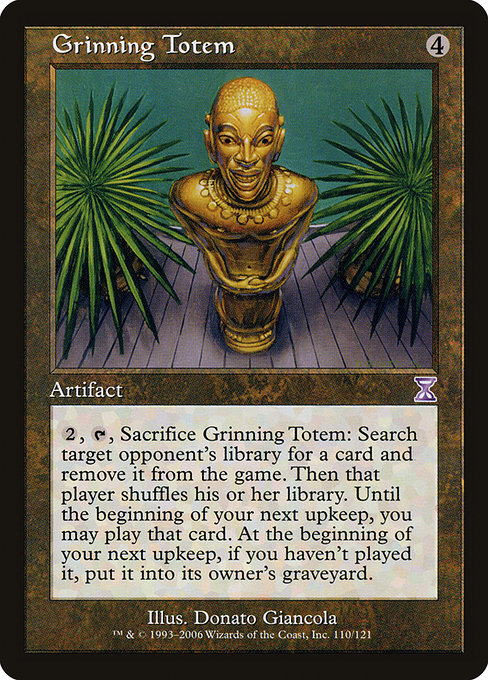
Image courtesy of Scryfall.com
Navigating MTG's Complex Interactions with Grinning Totem
MTG has long rewarded players who can juggle multiple threads of information at once. Grinning Totem, a colorless artifact from Time Spiral Timeshifted, stands as a compact classroom on cognitive load. For four mana, you gain a delayed but potent engine: exile a card from an opponent's library, then you may play that card until your next upkeep—provided you act in a timely fashion. If you don’t, the card heads to its owner’s graveyard. It’s a design that sparkles with tactical nuance and a dash of mind-bending tempo 🧙🔥💎.
How the interaction unfolds in real time
Mechanically, the card asks you to perform a straightforward action (sacrifice Grinning Totem, search an opponent’s library for a card, exile it, and shuffle) and then manage a separate, temporally bounded opportunity (play that exiled card until your next upkeep). The cognitive load comes from two intertwined clocks: the moment you exile a card and the window during which you may cast it, all while timing your next upkeep correctly to avoid losing the opportunity. This isn’t just about card advantage; it’s about intentional memory, tempo, and the rhythm of your turn order ⚔️🎨.
True mastery isn’t just finding the best card to exile; it’s knowing when to pull the trigger and how to ride the clock until the cycle resets.
Key cognitive-load considerations to keep in mind
- Decision timing: Exiling a card is a choice with consequences that ripple across future turns. You must decide not only what to exile, but when to extract value from that exile—knowing you’ll need mana to cast it later if you choose to do so.
- Tracking the window: The “beginning of your next upkeep” clause creates a moving deadline. You need to remember that the card is in exile and that you have a one-turn-at-a-time opportunity to cast it before it disappears into the graveyard.
- Card identity awareness: Because the card you exile comes from an opponent’s library, recognizing what you’re granting them access to—and how that impacts their plan—adds a layer of strategic psychology to the moment. Opponents will also track this, influencing their own plays and safeguards 🧠🪄.
- Mana management and casting constraints: You may cast the exiled card using your mana, but if the card’s mana cost is steep or color-heavy, you’ll need to weave it into your plan. This forces you to balance immediate board impact against the potential future payoff.
- Counterplay awareness: In multiplayer formats, Grinning Totem’s effect can become a communal puzzle. Teammates and rivals alike weigh how exposing an opponent’s card could swing the table—creating social dynamics that are as much part of the puzzle as the rules text 🧩.
Practical deckbuilding and play patterns
In a modern-leaning or commander environment, Grinning Totem becomes a flexible tool for midrange and control shells. Because it’s colorless, you can slot it into a broad spectrum of archetypes that lean on artifact acceleration, tutors, or stax-like disruption—while also enabling a unique pseudo-tutor effect that fetches a single, choice card from an opponent’s library. The key is to tailor your supporting lines so you’re not just stealing a card, you’re shaping the moment you play it. Ramp, vendor effects, and card draw help you maximize the value you can realize from that temporary exile 🧙🔥.
Imagine gaming out a scenario: you exile a high-impact threat from your foe’s library, giving yourself a risk-free window to answer that threat later in the turn or the next upkeep. If you can weave in a few extra mana rocks or a way to untap or reuse the same window, you’ll push Grinning Totem from a clever trick into a recurring strategic lever. In commander circles, this can become a mind game about tempo and resource denial, where the payoff hinges on whether you can cast the exiled card before the clock runs out 🎲.
Lore, design, and the art of the grin
Donato Giancola’s illustration for this Artfacts-era artifact channels the classic totem-spirit vibe: ancient stone, a sly mouth carved into the grain, and a glimmer of mischievous intent. The grin in the image isn’t just aesthetic; it signals the card’s flavor of cunning and temporary manipulation of fate. In a game built on layers of hidden information and timing windows, a totem with a smile feels thematically right—an emblem of the unsaid choice that can tilt a match if you read the room correctly 🧙♂️🎨.
The Time Spiral Timeshifted set itself is a celebration of design experimentation, offering iconic reprints and quirky finishes. Grinning Totem’s “special” rarity and its evergreen legality in formats like Modern and Legacy make it a familiar-but-welcome challenge for players who relish a careful balance of risk and reward. It’s a card that rewards careful tracking, not just quick reflexes, and that’s what makes it a favorite for players who love the cognitive puzzle at the heart of MTG.
Value, access, and collector vibes
From a collector’s perspective, Grinning Totem sits in a space where nostalgia intersects with practical playability. In the market, its nonfoil and foil variations reflect the broader appeal of Time Spiral Timeshifted reprints. The card’s utility in casual to mid-power levels, combined with the thrill of temporarily pilfering an opponent’s choice, makes it a memorable centerpiece for players who enjoy the storytelling of a well-woven game night. If you’re curious about acquiring a copy, you’ll find it listed with a wide range of prices, and foil copies tend to be the centerpiece for many binders and display shelves 🧙🔥💎.
As you draft or assemble a deck with Grinning Totem, consider the broader ecosystem of cards that reward cerebral play: those that reward predicting your opponent’s next moves, or cards that create angles of attack that force your table to rethink their plans. The result is a dynamic where every turn becomes a dialogue—a negotiation between intellect and instinct, with the totem serving as a playful, enigmatic moderator 🎲.